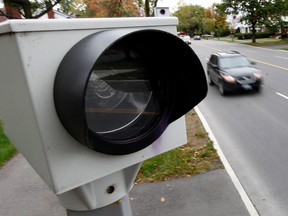The city’s auditor general has found millions of dollars in revenue generated by red-light cameras that could have been invested in road safety initiatives has instead been allocated to the city’s general operating budget and to Ottawa police. The city launched its red-light camera pilot project in 2000 with two cameras rotating between eight locations. The program was extended and expanded to install 85 cameras in permanent locations by 2022.
New red-light cameras installed after 2020 have generated $10.7 million that could have been transferred to the city’s road safety reserve fund, according to a report from Auditor General Nathalie Gougeon. The road safety reserve fund was established to “ensure sustained investment in road safety initiatives,” and, in 2019, council directed that all revenue from automated traffic enforcement be allocated to the city’s Road Safety Action Plan.

“Since that council direction, no revenues from net new red-light cameras has been allocated to the road safety reserve fund,” the auditor general report stated. The audit found more than $41 million in revenue from red-light cameras from 2021 to 2024, with 80 per cent of that revenue allocated to the city’s general operating budget, while the remaining 20 per cent — about $8.4 million — was transferred to the Ottawa Police Service.
City managers set a “baseline target” of $11.75 million in revenue, but the audit found the program has fallen short of that target, despite the installation of 24 new cameras since 2020. The shortfall was likely caused by a “combination of changes in driver behaviour and the result of the pandemic, with less cars on the road,” the audit states.
An estimated $3 million was earmarked for the OPS “to help close a funding gap.” The city “did not have an expectation that the funds would specifically be used for road safety,” Gougeon stated. “Based on our own analysis of ticket volume generated by new red light cameras introduced after 2020, approximately $10.
7 million in gross revenue has been generated by these cameras that could have been transferred to the road safety reserve fund. “Not allocating net new revenues..
. means that these funds will not be used exclusively for road safety initiatives,” Gougeon stated, which can “impact the level of public trust in the program” and “limit road safety outcomes” that could have been achieved with red-light camera revenues. The auditor general also found that revenues generated through photo radar cameras are not being formally reported in the city’s Road Safety Action Plan annual report.
Council approved a further annual transfer of $1 million to Ottawa police from its automated speed enforcement (photo radar) program, commencing in 2025. “This places even greater importance on monitoring and reporting of the use of funds transferred to others,” Gougeon stated. Formal reporting of those revenues “would increase transparency and better demonstrate the value of the program and how it is contributing to the overall goal of improved road safety.
” College Coun. Laine Johnson said she will be asking some “tough questions” when the report is tabled at the April 29 audit committee meeting. “This is a problem,” Johnson said in a social media post last week.
“We were promised that all of the fines from (automated speed enforcement) and red-light cameras would go to improve road safety and the books show that it isn’t. The lack of transparency is disturbing.” During council’s last budget debate, Johnson raised the issue of revenue being transferred to Ottawa police, “because it isn’t my understanding of how the program was supposed to work,” she said.
“Every year, I go hat in hand to staff asking for road safety improvements in College Ward,” Johnson wrote. “Safer crossings, better intersections, more adult crossing guards. And every year I’m told, ‘We don’t have the money.
’ “Now we know: the money is there, but it’s being redirected to other purposes.” The photo radar program yielded $5 million in net revenues in 2023 and $29 million in 2024. The auditor general’s report recommends that staff “revisit the approach for allocating revenues from the red-light camera program to the road safety reserve fund to ensure alignment with council’s expectations.
” The report also recommends that the city’s public works staff review and update the “measurement and reporting” for both the photo radar and red-light camera programs “to ensure each fully demonstrates their contributions to expected outcomes.” Staff should also report on the amount of money transferred to Ottawa police through the photo radar program, the report stated, and staff should work “collaboratively with Ottawa Police Service’s traffic services unit to establish a reporting mechanism on how funds transferred are being utilized; specifically, those expected to be used towards road safety.” ahelmer@postmedia.
com Our website is your destination for up-to-the-minute news, so make sure to bookmark our homepage and sign up for our newsletters so we can keep you informed. RelatedHow long is your wait for early voting in Ottawa?Deachman: Westboro bus-crash inquest is filling in important details.
Health

Road safety fund shut out of $41 million red-light camera revenue

Millions of dollars generated by red-light cameras have instead been allocated to the city's general operating budget and to Ottawa police.















